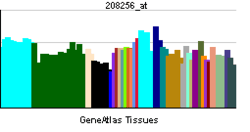Ephrin A2
Ephrin-A2 is a protein that in humans is encoded by the EFNA2 gene.[3]
This gene encodes a member of the ephrin family. The protein is composed of a signal sequence, a receptor-binding region, a spacer region, and a hydrophobic region. The EPH and EPH-related receptors comprise the largest subfamily of receptor protein-tyrosine kinases and have been implicated in mediating developmental events, particularly in the nervous system. Based on their structures and sequence relationships, ephrins are divided into the ephrin-A (EFNA) class, which are anchored to the membrane by a glycosylphosphatidylinositol linkage, and the ephrin-B (EFNB) class, which are transmembrane proteins. Posttranslational modifications determine whether this protein localizes to the nucleus or the cytoplasm.[3]
References
Further reading
- Flanagan JG, Vanderhaeghen P (1998). "The ephrins and Eph receptors in neural development". Annu. Rev. Neurosci. 21: 309–45. doi:10.1146/annurev.neuro.21.1.309. PMID 9530499.
- Zhou R (1998). "The Eph family receptors and ligands". Pharmacol. Ther. 77 (3): 151–81. doi:10.1016/S0163-7258(97)00112-5. PMID 9576626.
- Holder N, Klein R (1999). "Eph receptors and ephrins: effectors of morphogenesis". Development. 126 (10): 2033–44. PMID 10207129.
- Wilkinson DG (2000). "Eph receptors and ephrins: regulators of guidance and assembly". Int. Rev. Cytol. International Review of Cytology. 196: 177–244. doi:10.1016/S0074-7696(00)96005-4. ISBN 978-0-12-364600-2. PMID 10730216.
- Xu Q, Mellitzer G, Wilkinson DG (2001). "Roles of Eph receptors and ephrins in segmental patterning". Philos. Trans. R. Soc. Lond., B, Biol. Sci. 355 (1399): 993–1002. doi:10.1098/rstb.2000.0635. PMC 1692797
 . PMID 11128993.
. PMID 11128993.
- Wilkinson DG (2001). "Multiple roles of EPH receptors and ephrins in neural development". Nat. Rev. Neurosci. 2 (3): 155–64. doi:10.1038/35058515. PMID 11256076.
- Gale NW, Holland SJ, Valenzuela DM, et al. (1996). "Eph receptors and ligands comprise two major specificity subclasses and are reciprocally compartmentalized during embryogenesis". Neuron. 17 (1): 9–19. doi:10.1016/S0896-6273(00)80276-7. PMID 8755474.
- Ephnomenclaturecommittee (1997). "Unified nomenclature for Eph family receptors and their ligands, the ephrins. Eph Nomenclature Committee". Cell. 90 (3): 403–4. doi:10.1016/S0092-8674(00)80500-0. PMID 9267020.
- Cerretti DP, Nelson N (1998). "Characterization of the genes for mouse LERK-3/Ephrin-A3 (Epl3), mouse LERK-4/Ephrin-A4 (Epl4), and human LERK-6/Ephrin-A2 (EPLG6): conservation of intron/exon structure". Genomics. 47 (1): 131–5. doi:10.1006/geno.1997.5088. PMID 9465306.
- Ciossek T, Monschau B, Kremoser C, et al. (1998). "Eph receptor-ligand interactions are necessary for guidance of retinal ganglion cell axons in vitro". Eur. J. Neurosci. 10 (5): 1574–80. doi:10.1046/j.1460-9568.1998.00180.x. PMID 9751130.
- Aasheim HC, Pedeutour F, Grosgeorge J, Logtenberg T (1998). "Cloning, chromosal mapping, and tissue expression of the gene encoding the human Eph-family kinase ligand ephrin-A2". Biochem. Biophys. Res. Commun. 252 (2): 378–82. doi:10.1006/bbrc.1998.9618. PMID 9826538.
- Gerlai R, Shinsky N, Shih A, et al. (1999). "Regulation of learning by EphA receptors: a protein targeting study". J. Neurosci. 19 (21): 9538–49. PMID 10531456.
- Hattori M, Osterfield M, Flanagan JG (2000). "Regulated cleavage of a contact-mediated axon repellent". Science. 289 (5483): 1360–5. doi:10.1126/science.289.5483.1360. PMID 10958785.
- Rodger J, Lindsey KA, Leaver SG, et al. (2002). "Expression of ephrin-A2 in the superior colliculus and EphA5 in the retina following optic nerve section in adult rat". Eur. J. Neurosci. 14 (12): 1929–36. doi:10.1046/j.0953-816x.2001.01822.x. PMID 11860487.
|
|---|
|
| Angiopoietin | |
|---|
|
| CNTF | |
|---|
|
| EGF (ErbB) | |
|---|
|
| FGF | | |
|---|
| |
- Agonists: Ersofermin
- FGF (1, 2 (bFGF), 3, 4, 5, 6, 7 (KGF), 8, 9, 10 (KGF2), 17, 18, 22)
- Palifermin
- Repifermin
- Sprifermin
- Trafermin
- Antibodies: Aprutumab
- Aprutumab ixadotin
|
|---|
| | |
|---|
| | |
|---|
| Unsorted | |
|---|
|
|---|
|
| HGF (c-Met) | |
|---|
|
| IGF | |
- Kinase inhibitors: Linsitinib
- NVP-ADW742
- NVP-AEW541
- OSl-906
|
|---|
| | |
|---|
| Others |
- Cleavage products/derivatives with unknown target: Glypromate (GPE, (1-3)IGF-1)
- Trofinetide
|
|---|
|
|---|
|
| LNGF | |
|---|
|
| PDGF | |
|---|
|
| RET (GFL) | | |
|---|
| | |
|---|
| | |
|---|
| | |
|---|
| Unsorted |
- Kinase inhibitors: Agerafenib
|
|---|
|
|---|
|
| SCF (c-Kit) | |
|---|
|
| TGFβ | |
|---|
|
| Trk | | |
|---|
| |
- Agonists: 3,7-DHF
- 3,7,8,2'-THF
- 4'-DMA-7,8-DHF
- 7,3'-DHF
- 7,8-DHF
- 7,8,2'-THF
- 7,8,3'-THF
- Amitriptyline
- BDNF
- Deoxygedunin
- Diosmetin
- HIOC
- LM22A-4
- N-Acetylserotonin
- NT-3
- NT-4
- Norwogonin (5,7,8-THF)
- R7
- TDP6
|
|---|
| | |
|---|
|
|---|
|
| VEGF | |
|---|
|
| Others |
- Additional growth factors: Adrenomedullin
- Colony-stimulating factors (see here instead)
- Connective tissue growth factor (CTGF)
- Ephrins (A1, A2, A3, A4, A5, B1, B2, B3)
- Erythropoietin (see here instead)
- Glucose-6-phosphate isomerase (GPI; PGI, PHI, AMF)
- Glia maturation factor (GMF)
- Hepatoma-derived growth factor (HDGF)
- Interleukins/T-cell growth factors (see here instead)
- Leukemia inhibitory factor (LIF)
- Macrophage-stimulating protein (MSP; HLP, HGFLP)
- Midkine (NEGF2)
- Migration-stimulating factor (MSF; PRG4)
- Oncomodulin
- Pituitary adenylate cyclase-activating peptide (PACAP)
- Pleiotrophin
- Renalase
- Thrombopoietin (see here instead)
- Wnt signaling proteins
- Additional growth factor receptor modulators: Cerebrolysin (neurotrophin mixture)
|
|---|
|
- See also: Peptide receptor modulators
- Cytokine receptor modulators
|

 . PMID 11128993.
. PMID 11128993.